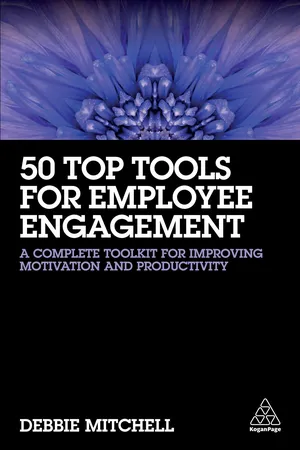
50 Top Tools for Employee Engagement
A Complete Toolkit for Improving Motivation and Productivity
- English
- ePUB (mobile friendly)
- Available on iOS & Android
50 Top Tools for Employee Engagement
A Complete Toolkit for Improving Motivation and Productivity
About This Book
Engaged employees are more productive, motivated and resilient, yet gaining financial support to develop engagement is harder than ever as budgets are being squeezed and everyone is being asked to do more with less. 50 Top Tools for Employee Engagement shows that you don't need expensive interventions or additional resource to achieve employee engagement. It contains practical tools which can be used to make an immediate difference to engagement, whether you're working with individuals, teams or the organization as a whole. Each tool in 50 Top Tools for Employee Engagement includes guidance on when to use it, how long it will take and useful hints and tips to help get the most out of it. Most importantly, this book will give guidance on how to measure the impact of each tool to show what's working and where efforts are best focused. Addressing all the key areas of engagement throughout the employee life cycle, from talent attraction and induction to career progression and development, this book is a complete resource to engaging your workforce.
Frequently asked questions
Information
02
Engaging teams
7 Dialogue sheets
Best when
Best for
Resources
Outcomes
Process
- Identify four to six statements about the issue/project/change, or select key words from a vision statement or mission that could prompt good discussion (controversial can be good!) and write them in the corners of a large sheet of paper.
- Invite small groups (around six people) to get coffee and biscuits (promote informality), put the sheet of paper on the table and invite them to discuss, write comments, questions, etc.
- Minimal intervention from a facilitator allows freedom of discussion and debate within the team.
- Allow around 30 minutes for discussion – and then give the group a chance to give feedback to a facilitator.
- Key points should be noted and fed back to key stakeholders.
Hints and tips
- Make this process have the feel of a social occasion. Encourage participants to bring coffee (or provide it in the room) and offer sweets, biscuits or donuts.
- Poster Pigeon offer extremely good value poster sized prints on their basic quality paper – which is perfect for a dialogue shee...
Table of contents
- Cover
- Title Page
- Copyright
- Contents
- List of Figures
- List of Tables
- About the author
- Preface
- Acknowledgements
- About this book
- Introduction
- 01 Engaging one on one
- 02 Engaging teams
- 03 Engaging the organization
- 04 In talent attraction
- 05 In induction
- 06 In training
- 07 When life changes happen
- 08 When career changes happen
- 09 On retirement
- 10 On leaving
- 11 For business improvement
- 12 In change
- 13 For customer focus
- 14 In delivering results
- 15 Evaluating your engagement initiatives
- 16 Quick view of tools and templates
- References
- Index
- Backcover